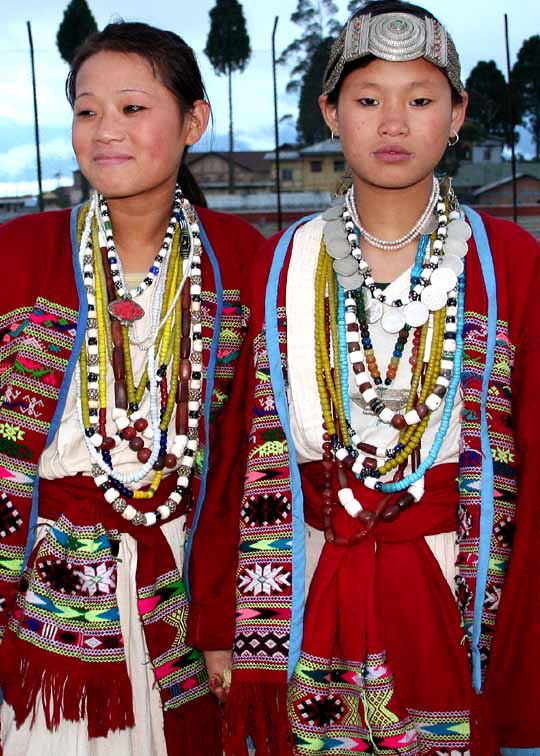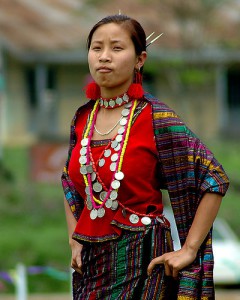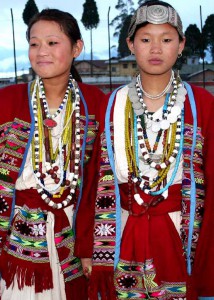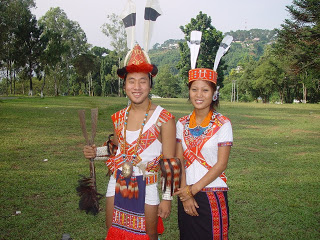
Tribal Clothing From Arunachal Pradesh
The state of Arunachal Pradesh is an exotic collection of socio-cultural life that blends many types of cultures, and traditions. Shawls, skirts, wraps, lungis are the fashion favorites here. With 26 distinct tribes and over 100 sub-tribes, Arunachal Pradesh is a treat for those interested in a glimpse of cultural diversity. Being essentially a tribal state, festivals and social events like weddings are an integral part of the life of the people here.
Origin and history
The major tribes of Arunachal Pradesh are Adi, Aka, Galo, Nyishi, Apatani, Bori, Tagnis, and Bokar.
While most tribes are ethnically similar, having derived from the same ancestors, their geographical separation has brought in the different customs in dressing styles. The tribes of Arunachal Pradesh are known for their weaving, with the Aptani tribe being the most advanced in its techniques. Using fibers from trees, goat and human hair, they create ceremonial coats, shawls, skirts, sashes, lungis (loin cloths) with various forms of embroidery.
Sources of Inspiration
Geometric patterns dominate the clothing worn by the Adi, Aptani and Mishmi tribes, with the most popular motif being that of angular designs and zig-zag lines. Even floral patterns take on a more geometric form in fabrics of these regions. Other common patterns to be seen are stripes. The simple, straight lines in the clothes of Adi and Aptani tribes are reflective of a more disciplined way of life, while the Mishmis display more celebratory patterns in their attires.
The colors and designs on fabrics hold a symbolic meaning for every tribe. For example, in Tuensang, motifs of shapely pointed triangles depict arrows or hornbills, and the small red squares on a sanctum cloth represent ferment used for making beer. The Color red in shawls symbolizes blood enemies, blue stands for sky, and black represents the night.
Varieties
Women wear a sleeveless chemise with an embroidered, full-sleeves jacket, along with a petticoat or skirt. The attire is never usually complete without ‘Mushaiks’ or waistcoat. A skull- cap filled with Yak hair, called as the ‘Gurdam’, adds elegance to the overall attire.
Belts are an important part of costumes for women, both in daily wear and ceremonial dresses, and in fact, is a symbolic representation of the social and marital status of girl. Unmarried and married Adi women wear different types of belts around their waist.
Present day scenario
The clothing styles and designs have largely been uninfluenced in Arunachal Pradesh and tribal communities still wear their ethnic costumes for ceremonial functions. However, there are small-scale inspirations in form of motifs that have made their way into the state’s clothing designs from Tibet and Bhutan. This is evident in some weaves of the Monopa tribe.
Accessories
The major accessories worn during a tribal wedding ceremony are the BiangSipi (chain of blue colored beads), Talei (mixed sized bowls), Buah tap and KamkoTap (bangles worn by the groom), Bauhche (bridegroom’s sword), BuahGatjiang (red colored bead fastened on the left wrist of the groom), Koktung or the headgear, DoumuiChe (Bride’s sword), Habo Terri (garland worn by girls), rectangle-shaped jewellery called Pebar, and bead chains of various kinds known as Sampu, Sangiang, Anabou and Sengme.
The main craft forms of the region are based on cane and bamboo, and people create beautiful hats with embellishments of beaks and feathers of birds. Silver rings and earrings embroidered with variously colored beads are a popular fashion accessory in the region.
Interesting facts and comparison
- Four types of wedding ceremonies are practiced by the Galo tribe of Arunachal Pradesh: ‘Kartv, ‘Karoo, ‘Karmwk, and ‘Karsuk.
- The dressing styles follow a hierarchical system in many tribes of Arunachal Pradesh. For example, in Wanchoo tribe, a certain type of blue band for arms and legs can only be worn by members of the chief’s family.
- Married women in Arunachal Pradesh wear a yellow necklace with coiled earrings, while the ornament for unmarried women is the ‘Beyop’.
Reference
Categories: Attires, Clothing Styles & Drapes



